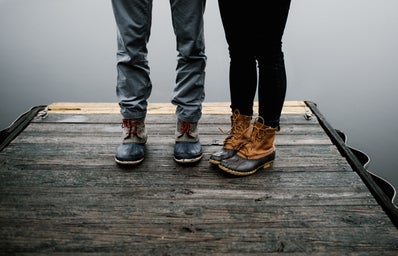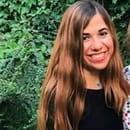It was 2001. My tiny fingers reached into the box on the table, wrapping themselves around a jumbo-sized stick of blue. With that crayon, I started coloring bright circles around two little black dots, each enclosed within another black circle. This was practically a daily ritual, as I usually wrote about my family in my kindergarten journal, and I needed to depict my grandmother’s eyes – great, big pools of cerulean, full of exotic wonder whenever little me compared them with her own chocolate brown.
That was, until one evening, when my innocence would be shattered. Grandma stood in front of her bathroom sink as I ran into her room. She removed each of her contacts to reveal deeply pigmented rings— a naked set of eyes that I would soon find gazing upon my own. There we stood, speechless. Two brown-eyed girls. One was caught up in a lie. The other, as a result, had seriously screwed up her kindergarten journals.
I’ve been fascinated with eye colors ever since. As I got older, I learned that genetics determined someone’s natural color, although they could be masked with tinted lenses like my grandmother’s “digital eyes,” as my cousin David liked to call them. In ninth grade, I fell hard for my first green-eyed boy. So, during a lesson in biology class on inheritance, I began to doodle a young child with an emerald glare, wondering which combination of genes could create such a magical set. Upon noticing this, my teacher stood over my desk. “Look up at me,” she demanded.
“You will, in all likelihood, never have a child with any other eye color than your own. That shade of brown is deep enough that you likely carry two dominant genes.” And with that, she walked away. Although I knew my teacher’s idea might not have been accurate, as the origin of someone’s eye color is a lot more complicated than how our high school textbook put it, it still hurt to hear. I love my brown eyes, and would be thrilled to pass down the same shade I share with my mother and grandmother — but I also want my future kids to have a shot at having their father’s color or with my grandfather’s crystalline azure.
In Around Sarah’s Table, a novel featuring the stories of ten Hasidic Jewish women recounted over a series of Tuesday lunches, authors Rivka Zakutinsky and Yaffa Leba Gottlieb bring up the case of Levi, a young man who insists he gets matched with a green-eyed wife. His mother, Tamar, became furious at the hired matchmaker after Levi rejected three girls who otherwise seemed perfectly fine; she thought an eye color requirement seemed superficial. But the matchmaker simply laughed. “Green eyes, I’ve got. Green nails, green hair, that’s a problem.” She soon found Levi a match, one that happened to be a better fit than the first three — and also happened to have green eyes. “Sometimes,” the matchmaker explained, “these unreasonable preferences, those peculiar requests, are actually the signposts that lead a young person to their richtige zivvug – their best destined mate.” This match, an ideal soulmate, would help Levi to reach his fullest potential. “Green eyes? Of course. I respect that,” she continued.
“Green eyes may mark his match.”
And in high school, I would be left to figure out if green eyes also marked my own. Despite only occurring in about 2 percent of the world’s population, I managed to find more than a handful of them throughout those four years. I developed crushes on a string of Jewish boys ranging from saxophonists, camp counselors, lacrosse players, baritone singers and debate team champions—and, you guessed—they all had green eyes. Although there were a few exceptions (one notable crush had similar brown eyes to mine), my best friends and I were definitely able to see a pattern. Once I started college, though, my preference appeared to switch to blue. Over the course of my freshman year, I went on dates with a budding chemist, a guitarist in a local band, and a fraternity president. All were to no avail.
However, there was one guy who was different. I had met him through a group of friends during a dinner at UF Hillel, and he had eyes the color of jade. Although we didn’t go on any dates, I was able to meet up with him again one day for about ten minutes in one of the campus dining halls. As freshmen, this could have arguably counted as a date, had he not ditched halfway through our conversation to meet up with someone at the gym — and left me to pay for my own food. Since he clearly wasn’t interested, I didn’t really bother talking to him again until the beginning of sophomore fall, when he happened to be in one of my lectures. I took this as a sort of sign. Clearly, even after all of those blue-eyed dates, I was still drawn to green eyes, especially with a set like these.
But after meeting up with this guy at Starbucks after class one afternoon, we realized we definitely didn’t click as anything more than casual friends. He was nice, but I couldn’t see myself with someone who didn’t like coffee, had very different taste in music, and was so much more reserved in conversation. We would continue to say hello in passing and occasionally text about homework, but his role in my life was otherwise over. Within a week, though, I’d meet yet another green-eyed boy.
This one actually liked Starbucks, and he was the first guy with which I didn’t feel weird about sharing a Frappuccino straw. He made me laugh like no one else, and, two years later, we’re still keeping each other around. Just like the matchmaker had explained in Levi’s story, Perry and I are able to help each other reach our fullest potential. He’s one of the most supportive and loving people anyone could meet, and I’m lucky to have him in my life.
We sat together on his couch a few nights ago as he recounted some of his favorite traits. “You’re always there for others, like when my friend got sick and you helped me take care of him, even though it meant skipping dinner. . . and of course, you’re absolutely beautiful, with your brown eyes, staring into my hazel –”
I started screaming. It took us a few minutes to understand what had just happened. Perry looked at me, helplessly confused. “What? My eyes are hazel! What did I do wrong?”
Because Perry is partially color blind, he sees shades of red and green in more muted tones than does the general population—so even though he has green eyes, he’s never been able to see their true color. Instead, he sees his eyes as having tones of gray.
I had never connected the dots.
When I look into Perry’s eyes, I see them with all of their colors, from lush forest to sparkling peridot. And I can just as clearly see his soul shining through, even in our darkest moments. It’s then that I realize he’s also able to see me for all that I am, even when I cannot always see myself in the same way. On the days where I feel that I’ve accomplished nothing, and on the nights I’ve cried myself to sleep, I could only see failure – but past my ache, Perry could only see my beauty, wisdom, and strength.
It’s only now that I can understand the meaning of a richtige zivvug. A right match. For those other boys – no matter their eye color – were colorblind to my worth. But it was always there. Even if I were to cloak myself with false pretense, like my grandmother’s irises concealed by blue, I was always there, and I was always destined for a love like this.
And Perry’s eyes were always just as green.



